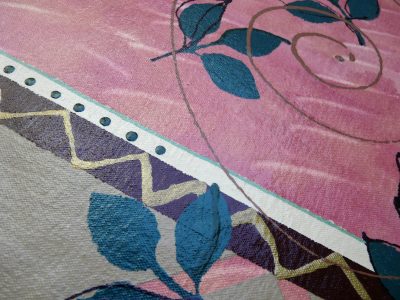Use and care of your Lizprintz creation
A painted Lizprintz creation will maintain its good looks for years to come. It is made of heavy canvas, acrylic paints, and several coats of urethane. Here are a few simple tips to keep it looking its best.
 Placemats and table art
Placemats and table art
Lizprintz placemats, table squares and table runners require little care and always look good. When they get diry, wipe them with a little warm, soapy water, then dry them with a dry cloth. Placemats get more use so should be wiped after every meal. Don’t forget to wipe the back of the mat, as well. If there is stubborn dirt, put a few drops of soapy water on the spot and let it soak for a few minutes, then gently rub with a cloth. Never put a Lizprintz creation in the washing machine!
Most people leave their placemats and table art on the table. If storing, do not fold as this will crack the urethane. Roll the piece or lay it flat.
Pet mats
Your pet mat has been made to be long lasting. If your dog or cat likes to move things around you may want to use an anti-slip underpad underneath it to keep it in place.
Clean up is easy. Just pick up the mat and dump any loose kibble in the garbage then wipe with warm soapy water, front and back. For dried on food, soak the spot and then gently rub. Do not put in the washer and store rolled or flat.
Floorcloths
Choosing a spot for your floorcloth
A floorcloth is suitable for any room with a hard floor, such as wood, linoleum, concrete or tile. It should not be used over carpeting. When placed over a soft surface, the floorcloth will flex under the weight of use. This will cause the painted surface to bend repeatedly, creating cracks in the paint and urethane.
 Installing your floorcloth
Installing your floorcloth
Before you install your new floorcloth, clean your chosen spot thoroughly.
It is also important to make sure that your floorcloth will stay in place. This can be done either by using double-sided tape or an anti-slip underpad. Attach protective felt pads to the bottom of any furniture that may be placed atop the floorcloth. This will make it easier to move the furniture around and will protect the floorcloth once it is in place. Lay the floorcloth in the intended spot and unroll slowly.
A floorcloth can stiffen in the cold weather. If your floorcloth has become cold through storage or transport, let it rest until it warms to room temperature, then unroll it slowly.
How to clean your floorcloth
Your floorcloth is very easy to maintain. First, vacuum the area well to remove any dirt, then damp mop using mild, soapy water and let dry. Be sure to check underneath the floorcloth especially around the edge and the corners where dirt loves to hide. Rinse the area and wipe dry. Do not use abrasive cleaners as they will damage the surface or oil soaps as they may leave a sticky residue.
Do not fold or bend your floorcloth. Do not put your floorcloth in the washing machine. Roll the floorcloth, if storing.
Do not leave your floorcloth sitting in water, and while it is possible to use your floorcloth on your deck, do not leave it outside in inclement weather or over the winter.
